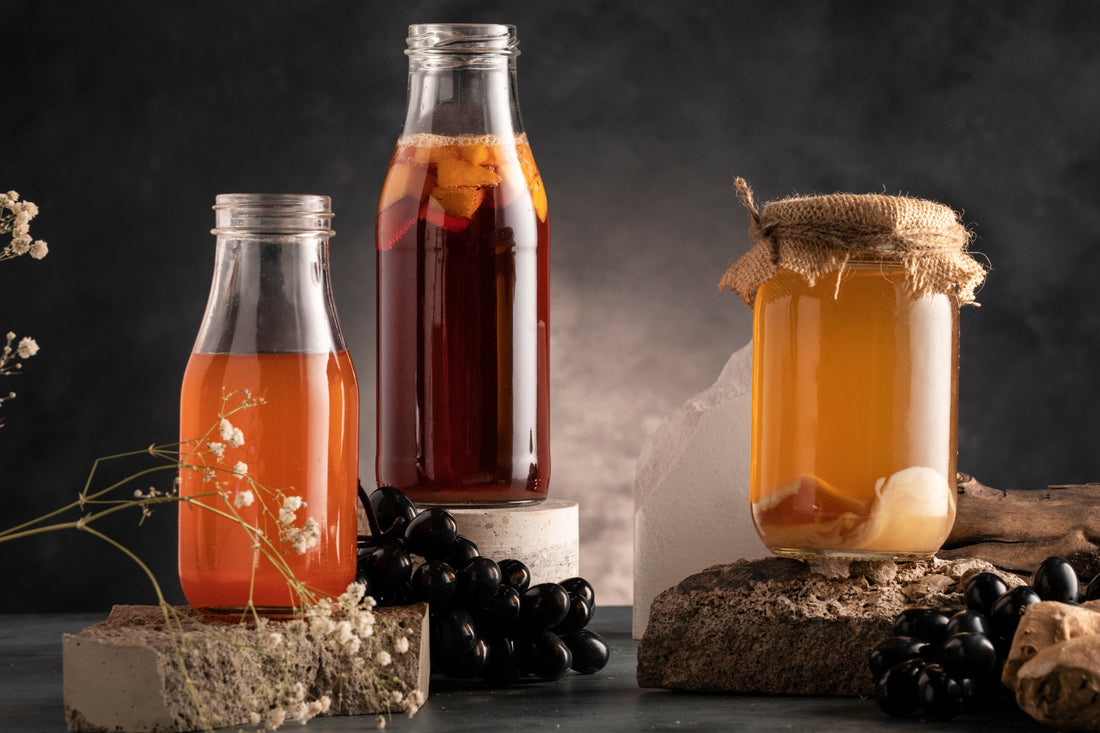
Do You Really Know Your Kombucha? Learn to Read Beyond Labels and Spot the Real from the Hype
ಹಂಚಿ
Do You Really Know Your Kombucha? Learn to Read Beyond Labels and Spot the Real from the Hype
Kombucha has exploded in popularity as a go-to fermented beverage for gut health and natural wellness. But with flashy labels, bold health claims, and a flood of brands in the market, how do you know if your kombucha is truly good for you? In this guide, we’ll teach you how to read beyond the marketing buzzwords and understand what really matters on that label.
Whether you're sipping for probiotics, detox, or just delicious fizz, understanding your kombucha empowers you to make better choices for your gut and overall health.
What Is Real Kombucha?
Real kombucha is a raw, fermented tea made using a SCOBY (Symbiotic Culture Of Bacteria and Yeast), sugar, and tea. It undergoes natural fermentation, producing beneficial probiotics, organic acids, and trace vitamins.
Primary Benefits of Authentic Kombucha:
- Rich in live probiotics for gut health
- Natural source of B vitamins and antioxidants
- Low in sugar post-fermentation
- Supports digestion, immunity, and detoxification
Why Labels Can Be Misleading
Many kombucha brands make claims like “zero sugar,” “with probiotics,” or “immunity booster,” — but not all claims are backed by actual fermentation or lab tests. Some are pasteurised (killing probiotics), diluted, or artificially carbonated.
Watch Out For:
- Pasteurised Kombucha: Heating kills live cultures. Look for “raw” or “unpasteurised.”
- Added Probiotics: Some add lab-grown probiotics to fake the benefit.
- Artificial Flavours & Preservatives: True kombucha should be naturally flavoured and preservative-free.
- Excess Sugar: Post-fermentation sugar should be minimal.
- Fizz from CO2: Real fizz is from secondary fermentation, not artificial carbonation.
- Shelf Life Over 12 Months: Raw kombucha with live cultures typically has a shelf life of 4–6 months under refrigeration. If a bottle claims 12+ months of shelf life without refrigeration, it’s most likely pasteurised or has preservatives — meaning the probiotics are likely no longer active.
How to Read a Kombucha Label Like a Pro
1. Ingredients First
Look for simple, whole ingredients:
- Tea (green, black, oolong)
- Sugar (cane sugar, jaggery — it's food for fermentation)
- Natural flavouring (fruits, herbs, spices)
- SCOBY or culture starter
2. Nutrition Facts
- Sugar: Should be low (<5g per 100ml post-ferment)
- Calories: Lower calories usually reflect better fermentation
- Probiotics: Look for actual strains (e.g., Lactobacillus, Bacillus coagulans)
3. Label Claims
- “Raw” or “Unpasteurised” = Live cultures
- “Naturally Fermented” = Good sign
- “Contains live cultures” = Better than just “probiotic drink”
The Truth About Popular Kombucha Claims
🔍 Claim: “Detoxes Your Body”
Reality: Kombucha supports your body’s natural detox functions, but it doesn’t “flush out toxins” magically.
🔍 Claim: “Boosts Immunity”
Reality: Probiotics help gut microbiota, which in turn supports immune function. It’s not a cure-all.
🔍 Claim: “No Sugar” or “Zero Sugar”
Reality: Sugar is needed for fermentation. If it says “zero sugar,” it’s either artificially sweetened or highly processed.
🔍 Claim: “No Refrigeration Needed”
Reality: Refrigeration is essential for raw kombucha as it slows down fermentation, helping preserve its natural flavour and probiotic content. Without refrigeration, kombucha continues to ferment, becoming overly sour or vinegary. A shelf life of 12 months or more without refrigeration is typically only possible through pasteurisation, preservatives, or by altering the traditional brewing process — all of which compromise the live cultures and gut health benefits of authentic kombucha.
How to Choose the Right Kombucha
- Go for small batch, cold-stored, and naturally carbonated kombucha.
- Prefer brands that are transparent about brewing methods and probiotic content.
- Trust your taste: real kombucha has a tangy, vinegary kick, not syrupy sweetness.
Signs of Real Kombucha:
- ✅ Slightly cloudy from live cultures
- ✅ Natural fizz when opened
- ✅ Complex, tart flavour
- ✅ Refrigeration needed
- ✅ Realistic shelf life of 4–6 months
Why FERMENTA Kombucha is the Real Deal
At FERMENTA, we stay true to the craft:
- Raw, live, and small-batch fermented
- No pasteurisation, no added lab-grown cultures
- Naturally carbonated with real fruits and herbs
- Always honest about ingredients and sugar levels
- Cold stored with a natural shelf life of 4–6 months
We believe in functional fizz that actually supports your gut health — not just sparkling juice with health claims.
FAQs
Q. Is all kombucha good for gut health?
A. Not necessarily. Only kombucha with live, unpasteurised cultures helps gut microbiome.
Q. Can kombucha have too much sugar?
A. Yes. Some brands add extra sugar post-fermentation. Look for <5g per 100ml.
Q. How long does kombucha stay probiotic?
A. When stored cold and unpasteurised, it can retain probiotics for 3–6 months.
Q. Does kombucha need refrigeration?
A. Yes, real kombucha must be refrigerated to preserve live cultures. Shelf-stable kombucha is often pasteurised and lacks live probiotics.
Final Thoughts
Next time you pick up a bottle of kombucha, don’t be swayed by trendy fonts or buzzwords. Look deeper, understand the process, and choose what’s genuinely good for your gut.
Share this blog with someone who loves kombucha but might not know what’s actually in their bottle.
👉 Explore our range of honest, gut-friendly brews at FERMENTA
